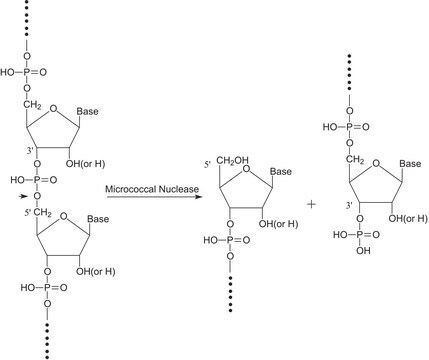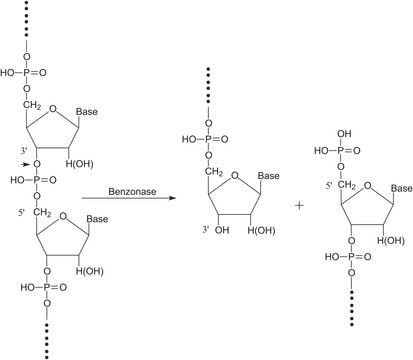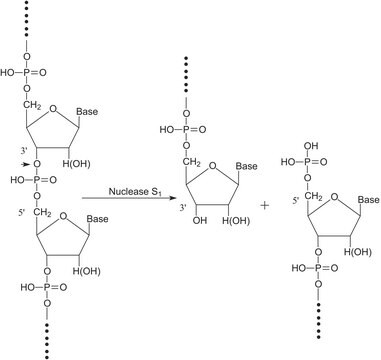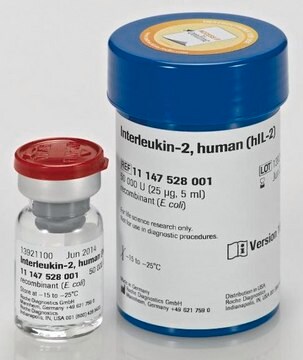10107921001
Roche
Nuclease S7
Micrococcal nuclease, from Staphylococcus aureus
Synonyme(s) :
s7 nuclease
Se connecterpour consulter vos tarifs contractuels et ceux de votre entreprise/organisme
About This Item
Code UNSPSC :
12352204
Produits recommandés
Source biologique
Staphylococcus aureus
Niveau de qualité
Forme
lyophilized
Activité spécifique
~15,000 U/mg
Conditionnement
pkg of 15,000 U
Fabricant/nom de marque
Roche
pH optimal
7.5
Conditions d'expédition
wet ice
Catégories apparentées
Application
- Removal of endogenous RNA from in vitro translation systems
- RNA sequencing experiments
Nuclease S7 has been used in ribonuclease selection process for ribosome profiling.
Actions biochimiques/physiologiques
Nuclease S7 is an endonuclease that mainly cleaves single-stranded substrates. It also cleaves double-stranded DNA or RNA. It cleaves the 5′-phosphodiester bonds of RNA and DNA to yield 3′-mononucleotides and oligonucleotides. Activity of the enzyme is dependent on Ca2+ and can be completely inactivated by the addition of EDTA. Nuclease S7 cleavage is highly specific to AT rich region than GC on the DNA.
Définition de l'unité
One unit releases a sufficient amount of acid-soluble oligonucleotides to produce an increase of 1.0 at A260.
Stockage et stabilité
Store unopened reagent at 2-8 °C; when diluted to 1 mg/mL, store at -15 to -25 °C.
Autres remarques
For life science research only. Not for use in diagnostic procedures.
Mention d'avertissement
Danger
Mentions de danger
Conseils de prudence
Classification des risques
Eye Irrit. 2 - Resp. Sens. 1 - Skin Irrit. 2 - Skin Sens. 1 - STOT SE 3
Organes cibles
Respiratory system
Code de la classe de stockage
11 - Combustible Solids
Classe de danger pour l'eau (WGK)
WGK 1
Point d'éclair (°F)
does not flash
Point d'éclair (°C)
does not flash
Faites votre choix parmi les versions les plus récentes :
Déjà en possession de ce produit ?
Retrouvez la documentation relative aux produits que vous avez récemment achetés dans la Bibliothèque de documents.
Les clients ont également consulté
Reimo Zoschke et al.
Proceedings of the National Academy of Sciences of the United States of America, 112(13), E1678-E1687 (2015-03-17)
Chloroplast genomes encode ∼ 37 proteins that integrate into the thylakoid membrane. The mechanisms that target these proteins to the membrane are largely unexplored. We used ribosome profiling to provide a comprehensive, high-resolution map of ribosome positions on chloroplast mRNAs
Serap Erkek et al.
Nature structural & molecular biology, 20(7), 868-875 (2013-06-19)
In mammalian spermatozoa, most but not all of the genome is densely packaged by protamines. Here we reveal the molecular logic underlying the retention of nucleosomes in mouse spermatozoa, which contain only 1% residual histones. We observe high enrichment throughout
Ribonuclease selection for ribosome profiling.
Gerashchenko M V and Gladyshev V N
Nucleic Acids Research, 45(2), e6-e6 (2016)
Maxim V Gerashchenko et al.
Nucleic acids research, 49(2), e9-e9 (2020-12-03)
There has been a surge of interest towards targeting protein synthesis to treat diseases and extend lifespan. Despite the progress, few options are available to assess translation in live animals, as their complexity limits the repertoire of experimental tools to
Sarah O'Keefe et al.
bioRxiv : the preprint server for biology (2020-12-04)
In order to produce proteins essential for their propagation, many pathogenic human viruses, including SARS-CoV-2 the causative agent of COVID-19 respiratory disease, commandeer host biosynthetic machineries and mechanisms. Three major structural proteins, the spike, envelope and membrane proteins, are amongst
Global Trade Item Number
| Référence | GTIN |
|---|---|
| 10107921001 | 4061838250483 |
Notre équipe de scientifiques dispose d'une expérience dans tous les secteurs de la recherche, notamment en sciences de la vie, science des matériaux, synthèse chimique, chromatographie, analyse et dans de nombreux autres domaines..
Contacter notre Service technique









![Guanosine 5′-[β,γ-imido]triphosphate trisodium salt hydrate ≥85% (HPLC), powder](/deepweb/assets/sigmaaldrich/product/structures/204/494/05808804-1ca7-44bf-b6c5-d4934dc7cb85/640/05808804-1ca7-44bf-b6c5-d4934dc7cb85.png)


